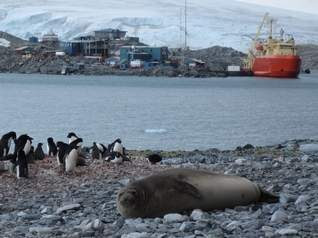
Researchers from Rutgers University spent four weeks at sea on the 247-foot research vessel Laurence M. Gould, gathering data on the changing climate in west Antarctica. (PHOTO COURTESY OF RUTGERS UNIVERSITY)

Seal and penguins in Antarctica, with research vessel Gould and palmer Station in background. (Photo by Oscar Schofield/Rutgers University).

Base Jubany, Antarctica
Local Time: 10:39 PM GMT (GMT +00)
Lat/Lon: 62.2° S 58.6° W
Elevation :: 13 feet
Temperature :: 42 °F
Conditions :: Partly Cloudy
Humidity :: 75%
Dew Point :: 37 °F
Wind :: 12 mph from the ESE
Pressure :: 28.86 in (Falling)
Visibility :: 7.0 miles
Clouds :: Scattered Clouds 1476 ft
Mostly Cloudy 9843 ft
(Above Ground Level)
Rutgers documenting Antarctic climate shift (click title to entry - thank you)
By Kirk Moore
STAFF WRITER
March 4, 2009
A pair of New Jersey-built undersea probes and eight Rutgers University researchers are documenting a dramatic climate shift near the bottom of the world, where warming currents off west Antarctica are remaking the ocean ecosystem — and dealing a wild card for predictions of global sea level rise.
"It's the fastest-warming area on Earth," said Oscar Schofield, a professor at the Rutgers Institute of Marine and Coastal Sciences, who recently returned from weeks at sea off the Antarctic Peninsula.
Scientists reckon that average temperatures on that side of the continent have risen since 1950, and the Rutgers team took its underwater vehicles and sensor technology there "to see how the ecosystem responds," Schofield said.
"The heat source down there isn't the atmosphere. It's the ocean," he said. "There's warmer water coming off the Antarctic circumpolar current. This is where the current is closest to the ice sheet."
Previously, most of the warming was thought to occur only on the peninsula pointing toward South America, said Colin Summerhayes, executive director of the Britain-based Scientific Committee on Antarctic Research and a member of International Polar Year's steering committee.
But now the committee reports wider warming. The biggest west Antarctic glacier, the Pine Island Glacier, is moving 40 percent faster than it was in the 1970s, discharging water and ice more rapidly into the ocean, Summerhayes said.
"If the west Antarctica sheet collapses, then we're looking at a sea level rise of between 1 meter and 1.5 meters," Summerhayes said. That would be a rise of 3 feet 4 inches to nearly 5 feet....
"The heat source down there isn't the atmosphere. It's the ocean," he said. "There's warmer water coming off the Antarctic circumpolar current. This is where the current is closest to the ice sheet."
Previously, most of the warming was thought to occur only on the peninsula pointing toward South America, said Colin Summerhayes, executive director of the Britain-based Scientific Committee on Antarctic Research and a member of International Polar Year's steering committee.
But now the committee reports wider warming. The biggest west Antarctic glacier, the Pine Island Glacier, is moving 40 percent faster than it was in the 1970s, discharging water and ice more rapidly into the ocean, Summerhayes said.
"If the west Antarctica sheet collapses, then we're looking at a sea level rise of between 1 meter and 1.5 meters," Summerhayes said. That would be a rise of 3 feet 4 inches to nearly 5 feet....